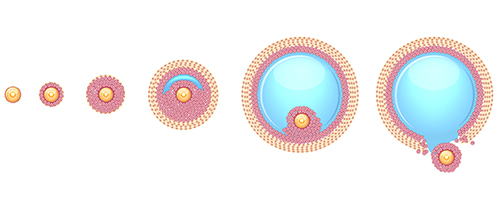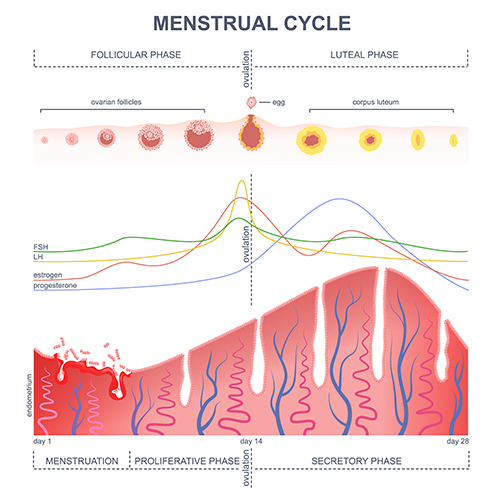Effect of hormones on the womb lining during the menstrual cycle:
The menstrual cycle reflects changes in the levels of circulating hormones, which act on the lining of the womb to cause it to become thickened and then to break down (the menstrual bleed) if pregnancy does not occur. The two hormones that act directly on the womb lining are oestrogen and progesterone. Both hormones are produced by follicles in the ovary, which also contain eggs. Oestrogen causes the lining to become thick. Progesterone blocks the effect of oestrogen and causes the lining to become “secretory”.
Follicle development and ovulation:
Follicles are little “chambers” that house eggs within the ovary. Each follicle contains one egg and undergoes a long period of development in order to produce an egg capable of supporting pregnancy. The image below shows the various stages of follicle development. At the extreme left is the earliest stage known as the primordial follicle stage. After growing for around 3 months in humans, primordial follicles develop to the “antral” stage; so-named because at this stage follicles have developed a small sac of fluid called an antrum (shown in blue). Growth of antral follicles is controlled by the hormone, FSH, which is produced by a small gland at the base of the brain called the pituitary gland. Under the influence of FSH, antral stage follicles produce oestrogen, the levels of which increase as antral follicles enlarge. When the antral follicle reaches around 2cm in diameter, it is induced to rupture and release its egg by another pituitary hormone called LH. This is known as ovulation and is shown at the extreme right of the image below.

Putting it all together – Hormones, follicles, ovulation and womb lining:
At the start of a menstrual cycle, FSH levels begin to increase causing a group of small antral follicles to begin developing. One follicle soon takes the lead and becomes the dominant antral follicle. As the dominant follicle grows under the influence of FSH, it produces more and more oestrogen that causes the lining of the womb to thicken or “proliferate”. Eventually, high oestrogen levels cause the pituitary gland to release a surge of LH (the LH surge), which causes the follicle to rupture and release its egg (see image above). The follicle from which the egg was released then becomes a corpus luteum and now starts producing the other major female hormone, progesterone. Progesterone causes different effects on the womb lining from oestrogen; progesterone blocks the effect of oestrogen and causes the lining to become “secretory”, which helps the embryo to implant and make a pregnancy. If pregnancy does not occur, progesterone eventually causes the lining to be shed as the menstrual bleed.

